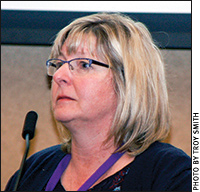ISBCW 2016:
Long-distance Transportation
Eight years of transportation research highlighted.
by Kasey Brown, senior associate editor
MANHATTAN, Kan. (June 9, 2016) — Long-distance transportation is a facet of the beef industry, and it can be a stressful event for cattle. Karen Schwartzkopf-Genswein, researcher at the Lethbridge Research and Development Centre for Agriculture and Agri-Food Canada, shared highlights of eight years of research on long-distance transportation to attendees of the fifth International Symposium on Beef Cattle Welfare in Manhattan, Kan., June 8-10.

“For every 1° Celsius (33.8° Fahrenheit) rise in ambient temperature, shrink increased 0.04%,” Karen Schwartzkopf-Genswein, researcher at the Lethbridge Research and Development Centre for Agriculture and Agri-Food Canada, noted.
There are many potential stressors in transportation — handling, novel environments, auction, commingling, restrictions of feed and water, environmental condition on the trailer, loading density, energy used to maintain balance during the trip, transport duration and potential for injury.
In each study, cattle were assessed non-invasively on both behavior and physiology, she noted. Additionally, infrared thermography and heart rates were used, plus 45 data loggers per truck.
“For every 1° Celsius (33.8° Fahrenheit) rise in ambient temperature, shrink increased 0.04%,” Schwartzkopf-Genswein noted.
Shrink reached 8% of body weight when cattle were on the truck up to 30 hours, and she recommends keeping time on the truck less than 30 hours. She added that delays, caused by border stops, unloading, driver rest, mechanical issues, traffic and weather averaged about 1 hour to 3 hours each, but maximums went up to 15 hours on top of normal transport time. She said that’s where experienced and forward-thinking drivers can help alleviate stress to avoid delays.
There is a relationship between driver experience and shrink, she said, sharing the following data.
| Driver experience | Avg. cattle shrink |
|---|---|
0-2 years |
5.09% |
3-5 years |
5.11% |
6-10 years |
4.79% |
>10 years |
4.86% |
Drivers with more than three years experience delivered cattle with considerably fewer welfare issues, such as lameness, nonambulatory cattle or dead cattle. Calves and cull cows were the most vulnerable to become compromised. Again, she recommend maximum truck time being less than 30 hours because more compromised cattle were observed when ride times exceeded 28 hours.
Ventilation is another concern. Comparing total humidity index on trailers with a punch hole pattern with 10% porosity and a duffy pattern with 12% porosity, it was found that the duffy pattern had a higher humidity index. The importance is how the air flows through the trailer, regardless of the size of the holes, she noted.
Ride quality differs through the trailer compartments. Vertical motion was similar in all compartments, while lateral motion was felt greatest in the back. Horizontal motion is greatest in the nose, back and the top of the back (called the doghouse in Canada and the jailhouse in the United States), she said.
Most welfare issues are exasperated when transport exceeds 30 hours, and longer journeys at higher temperatures increase shrink and poor welfare outcomes. In terms of stocking rates or density, she noted that cull cows and calves have an increased chance of being underloaded in the doghouse and nose compartments, thereby increasing injury.
“Even the best transporters and conditions cannot compensate for poor loading decisions,” she concluded.
Watch for additional coverage of the 2016 ISBCW on www.angus.media and in the Angus Journal and Angus Beef Bulletin. Comprehensive meeting coverage will be archived at www.api-virtuallibrary.com/meetings_other_news.html.
Editor’s Note: The articles used within this site represent a mixture of copyrights. If you would like to reprint or repost an article, you must first request permission of Angus Media by contacting the editor at 816-383-5200; 3201 Frederick Ave., Saint Joseph, MO 64506. Angus Media claims copyright to this we site as presented. We welcome educational venues and cattlemen to link to this site as a service to their audience.
